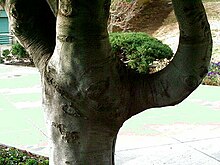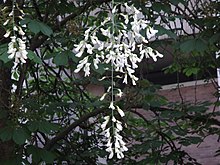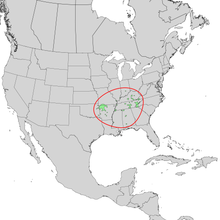|
Cladrastis kentukea
Cladrastis kentukea, the Kentucky yellowwood or American yellowwood (syn. C. lutea, C. tinctoria), is a species of Cladrastis native to the Southeastern United States, with a restricted range from western North Carolina west to eastern Oklahoma, and from southern Missouri and Indiana south to central Alabama. The tree is sometimes also called Virgilia.[3] Description Cladrastis kentukea is a small to medium-sized deciduous tree typically growing 10–15 metres (33–49 ft) tall, exceptionally to 27 metres (89 ft) tall, with a broad, rounded crown and smooth gray bark. The leaves are compound pinnate, 20–30 cm long, with 5-11 (mostly 7-9) alternately arranged leaflets; each leaflet broad ovate with an acute apex; 6–13 cm long and 3–7 cm broad, with an entire margin and a thinly to densely hairy underside. In the fall, the leaves turn a mix of yellow, gold, and orange.[citation needed] The flowers are fragrant, white, produced in Wisteria-like racemes 15–30 cm long. Flowering is in early summer (June in its native region), and is variable from year to year, with heavy flowering every second or third year. The fruit is a pod 5–8 cm long, containing 2-6 seeds.[citation needed]
DistributionOne of the rarest trees of eastern North America.[4] Found principally on the limestone cliffs of Kentucky, Tennessee and North Carolina, but it is hardy at the north to zone 4.[citation needed] The largest specimen known is at Spring Grove Cemetery in Cincinnati, Ohio, 22 m tall and 2.2 m trunk diameter; the tallest known is a slender tree 27 m tall but only 0.55 m trunk diameter, at Plott Cove Research Natural Area, Georgia (Spongberg & Ma 1997; Eastern Native Trees Society). Plants from Alabama have the leaves more densely hairy underneath than those from further north, and are distinguished as Cladrastis kentukea f. tomentosa (Steyermark) Spongberg.[citation needed] CultivationCladrastis kentukea is widely grown as an ornamental tree for its attractive flowers, and is locally naturalized in many areas of the eastern United States outside of its restricted native range.[3] It thrives in full sunlight and in well-drained soil, tolerates high pH soils as well as acid situations. The Yellowwood can withstand urban settings and is attractive to birds. A number of cultivars have been selected, including 'Perkin's Pink' (syn. 'Rosea', an invalid name) with pink flowers.[citation needed] Kentucky yellowwood is recommended as one of the best medium-sized trees for cultivation as an ornamental plant in gardens. The only quality that is mentioned is a tendency of the trunk to divide very near the ground, as a multi-trunked tree.[3]  UsesThe name yellowwood derives from its yellow heartwood, used in small amounts for specialist furniture, gunstocks and decorative woodturning.[citation needed] This plant has been marked as a pollinator plant, supporting and attracting bees and butterflies.[5] DistinctionsYellowwood won a Pennsylvania Horticultural Society Gold Award in 1994.[6] The Society of Municipal Arborists selected the yellowwood (Cladrastis kentukea or C. lutea) as its Urban Tree of the Year for 2015.[citation needed] References
External linksWikimedia Commons has media related to Cladrastis kentukea. |
||||||||||||||||||||||||||||||||||||||||||||||||
Portal di Ensiklopedia Dunia



